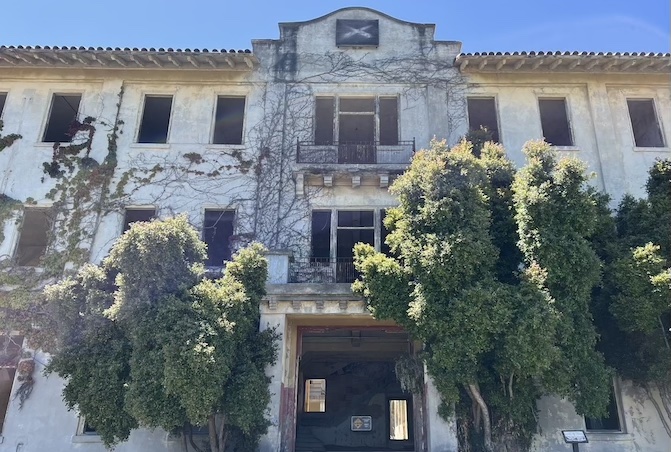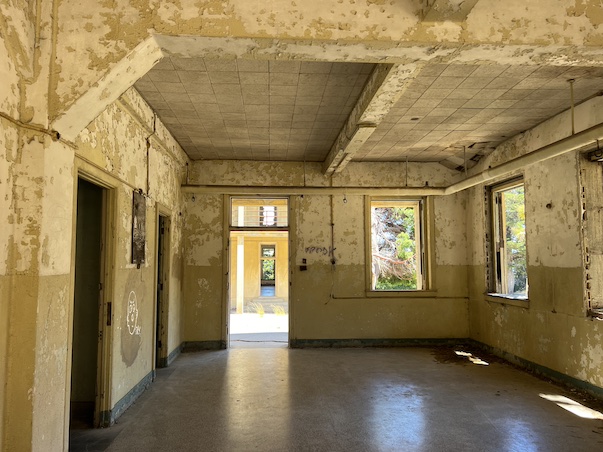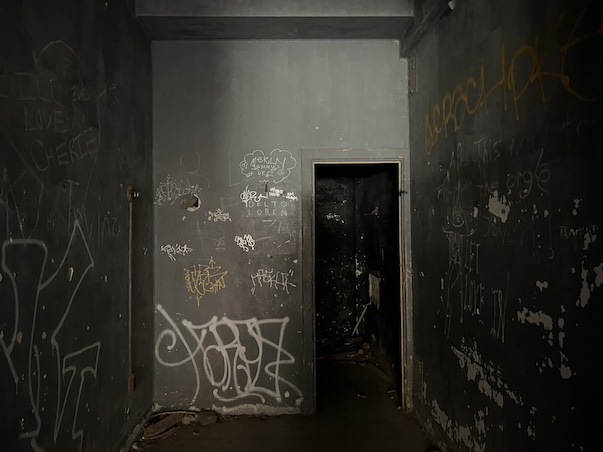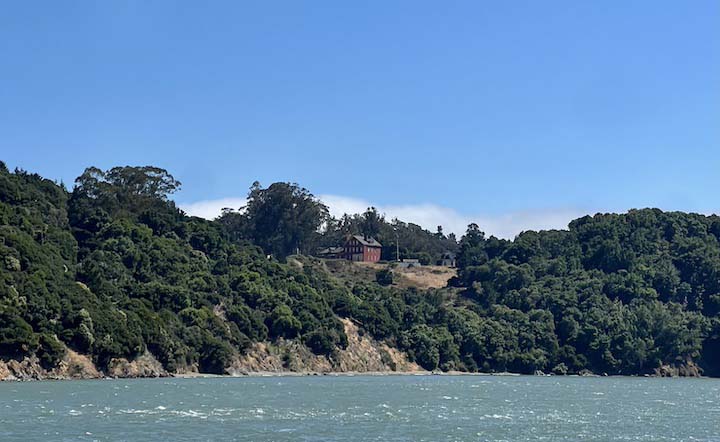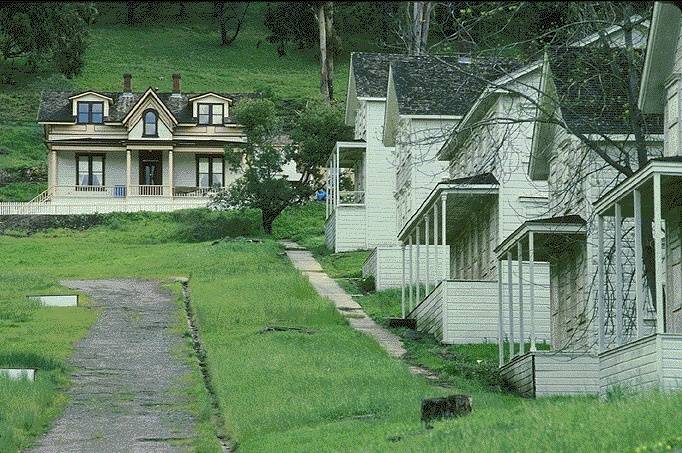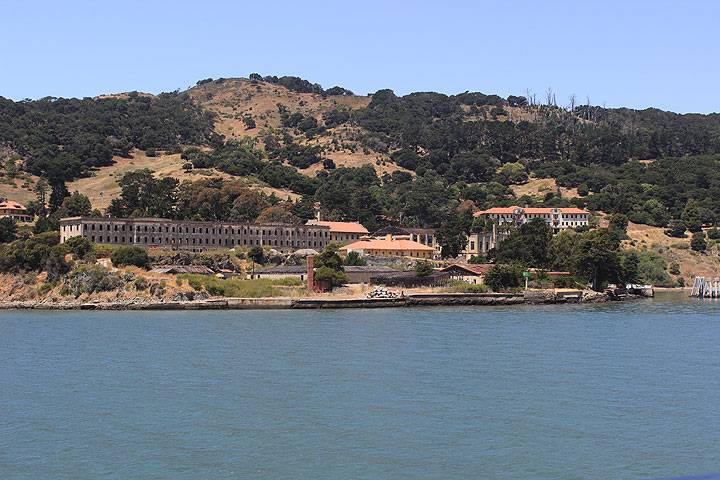Ghosts on Angel Island: Difference between revisions
EvaKnowles (talk | contribs) added in my text and LR's photos, kept some existing photos |
EvaKnowles (talk | contribs) added new photos |
||
| Line 3: | Line 3: | ||
''by Eva Knowles, 2024'' | ''by Eva Knowles, 2024'' | ||
[[Image:Angel Island | [[Image:Haunted Hospital Angel Island Exterior EK.jpg]] | ||
''' | '''Our "Haunted Hospital" at Fort McDowell, July 2024.''' | ||
''Photo: | ''Photo: Eva Knowles'' | ||
There is nothing more interesting to a child than a good ghost story, and Angel Island seemed to be full of them. I spent a week or two there each summer for three years, attending a day camp for elementary school children. My mother would drive me from my home in Mill Valley to Tiburon, where the camp staff would load us all onto the ferry. As the ferry began to pull away from the dock, we’d lean over the railing and see who could jump back quickly enough to not get a faceful of saltwater spray. We told stories to pass the time and watched the island grow closer and closer. | There is nothing more interesting to a child than a good ghost story, and Angel Island seemed to be full of them. I spent a week or two there each summer for three years, attending a day camp for elementary school children. My mother would drive me from my home in Mill Valley to Tiburon, where the camp staff would load us all onto the ferry. As the ferry began to pull away from the dock, we’d lean over the railing and see who could jump back quickly enough to not get a faceful of saltwater spray. We told stories to pass the time and watched the island grow closer and closer. | ||
| Line 15: | Line 15: | ||
But the best days of camp were Tuesdays, when our counselors—barely out of high school—would take us out of Ayala Cove, where the camp was stationed, and deeper into the island. They’d coax the smallest children along with Oreos, while those who knew what they were hiking towards would try to run ahead. | But the best days of camp were Tuesdays, when our counselors—barely out of high school—would take us out of Ayala Cove, where the camp was stationed, and deeper into the island. They’d coax the smallest children along with Oreos, while those who knew what they were hiking towards would try to run ahead. | ||
It was about two miles to Fort McDowell, which was home to the most exciting spot on the island: the “Haunted Hospital.” There were many surrounding buildings, but we never stopped to look too closely, because the biggest draw of the hospital was the fact that we were allowed to go inside a portion of the building. | |||
[[Image:Angel Island Haunted Hospital Interior EK.jpg]] | |||
'' | '''Inside the "Haunted Hospital," July 2024.''' | ||
''Photo: Eva Knowles'' | |||
The counselors lined us up and allowed us to enter a small dark room, barely the size of a closet, a few at a time. “You might see a ghost,” they said playfully. I can no longer remember what the room actually held, but I do remember what I ''thought'' I saw: an apparition of a brunette woman wearing a white apron. | |||
“I saw one!” I yelled triumphantly as I ran out of the room, a few other children on my heels. “I saw a ghost!” | “I saw one!” I yelled triumphantly as I ran out of the room, a few other children on my heels. “I saw a ghost!” | ||
[[Image: | [[Image:Angel Island Ghost Room EK.jpg]] | ||
''' | '''Our ghost chamber, July 2024.''' | ||
''Photo: | ''Photo: Eva Knowles'' | ||
The other children swarmed around me. “What did they look like?” “What were they doing?” One boy looked me straight in the eye and told me that he’d seen one too. We quickly compared notes, convincing each other, and ourselves, that we had seen the ghost of a nurse. | The other children swarmed around me. “What did they look like?” “What were they doing?” One boy looked me straight in the eye and told me that he’d seen one too. We quickly compared notes, convincing each other, and ourselves, that we had seen the ghost of a nurse. | ||
| Line 35: | Line 37: | ||
Many of the other children didn’t believe us. Seeing a few of them roll their eyes made my face grow hot. I had never been one to draw attention to myself. To this day I am less convinced that I was lying than that my third-grade imagination conjured up a ghost that felt, at least in the moment, wholly real. Either way, I stopped talking about the ghost, and walked the two miles back to Ayala Cove in an embarrassed silence. | Many of the other children didn’t believe us. Seeing a few of them roll their eyes made my face grow hot. I had never been one to draw attention to myself. To this day I am less convinced that I was lying than that my third-grade imagination conjured up a ghost that felt, at least in the moment, wholly real. Either way, I stopped talking about the ghost, and walked the two miles back to Ayala Cove in an embarrassed silence. | ||
The oldest children got to leave the cove on Thursdays, too. | [[Image:Camp Reynolds Hospital from Ferry.jpg]] | ||
'''Camp Reynolds Hospital from the Tiburon Ferry, July 2024.''' | |||
''Photo: Eva Knowles'' | |||
The oldest children got to leave the cove on Thursdays, too. We went the opposite direction, first coming upon a singular building, weathered and with many windows. We were told that this had also been a hospital, and I now know that it was Camp Reynolds Hospital. Our counselors would pull us closer together and shush us before beginning to tell us about the ghost that lived there. ''Sometimes the park rangers find the shutters open when they used to be closed, or closed when they used to be open. Sometimes they see a light go on, and hear a woman moaning, but when they come up from the beach there’s no one there.'' Now a year older and already jaded, I didn’t quite believe it. | |||
[[Image:outofsf$camp-reynolds.jpg]] | [[Image:outofsf$camp-reynolds.jpg]] | ||
| Line 46: | Line 54: | ||
When the game was over, we’d eat lunch at picnic tables beside the Garrison building. There was always a problem with yellowjackets, and soon we would decide that we’d had enough fun. We’d get off the ferry that afternoon and greet our parents with legends gleefully retold. To talk about one’s day at camp was to talk about ghosts. | When the game was over, we’d eat lunch at picnic tables beside the Garrison building. There was always a problem with yellowjackets, and soon we would decide that we’d had enough fun. We’d get off the ferry that afternoon and greet our parents with legends gleefully retold. To talk about one’s day at camp was to talk about ghosts. | ||
But what did we really know about the island, and the people who lived there? What ghosts did we think we were seeing? I can still imagine the ghost I thought I saw at Fort McDowell: the brunette woman we decided was a nurse. When I try to remember how I pictured the woman shouting from the window at the Camp Reynolds hospital, I imagine her similarly. | But what did we really know about the island, and the people who lived there? What ghosts did we think we were seeing? I can still imagine the ghost I thought I saw at Fort McDowell: the brunette woman we decided was a nurse. When I try to remember how I pictured the woman shouting from the window at the Camp Reynolds hospital, I imagine her similarly. | ||
[[Image:Angel-island-east-side-abandoned-buildings 2451.jpg]] | [[Image:Angel-island-east-side-abandoned-buildings 2451.jpg]] | ||
| Line 62: | Line 62: | ||
''Photo: Chris Carlsson'' | ''Photo: Chris Carlsson'' | ||
Yet the people who died on Angel Island were largely not white nurses, but Asian immigrants detained and confined to the island for sometimes as long as several years. Between 1910 and 1940, the Angel Island Immigration Station processed [[Island of Immortals: Chinese Immigrants and the Angel Island Immigration Station|hundreds of thousands of immigrants]], most of whom came from China. The conditions for detainees were prison-like—they were often separated from their families and subjected to grueling interrogations and invasive medical examinations. Visitors to Angel Island can still find melancholy [[Angel Island Poetry on the Walls|poems]], written in Chinese, etched into the walls. Many people committed suicide before getting the chance to leave the station. | |||
We children didn’t know about these ghosts, ghosts which are born from history instead of fantasy. They very well might have walked among us during those summers on the island—Angel Island continues to be a major destination for ghost hunters, who report strange electromagnetic activity and recordings of disembodied voices—but as we darted in and out of ruins, we did not know exactly who we were looking for. | We children didn’t know about these ghosts, ghosts which are born from history instead of fantasy. They very well might have walked among us during those summers on the island—Angel Island continues to be a major destination for ghost hunters, who report strange electromagnetic activity and recordings of disembodied voices—but as we darted in and out of ruins, we did not know exactly who we were looking for. | ||
Revision as of 10:58, 29 July 2024
"I was there..."
by Eva Knowles, 2024
Our "Haunted Hospital" at Fort McDowell, July 2024.
Photo: Eva Knowles
There is nothing more interesting to a child than a good ghost story, and Angel Island seemed to be full of them. I spent a week or two there each summer for three years, attending a day camp for elementary school children. My mother would drive me from my home in Mill Valley to Tiburon, where the camp staff would load us all onto the ferry. As the ferry began to pull away from the dock, we’d lean over the railing and see who could jump back quickly enough to not get a faceful of saltwater spray. We told stories to pass the time and watched the island grow closer and closer.
On most days, the camp could have been anywhere. It was a typical summer camp—we played games, made friendship bracelets, and fished for crawdads from the dock. I always held my hook, which carried a piece of string cheese, just above the surface of the water, because I wasn’t interested in catching a crawdad. We could play at the beach as long as we wore a life jacket and didn’t let the water go higher than our ankles. On Fridays, we’d have a barbecue with burgers and bags of Doritos. Each day we’d come home dusty, with tiny sticky burrs coating our sneakers.
But the best days of camp were Tuesdays, when our counselors—barely out of high school—would take us out of Ayala Cove, where the camp was stationed, and deeper into the island. They’d coax the smallest children along with Oreos, while those who knew what they were hiking towards would try to run ahead.
It was about two miles to Fort McDowell, which was home to the most exciting spot on the island: the “Haunted Hospital.” There were many surrounding buildings, but we never stopped to look too closely, because the biggest draw of the hospital was the fact that we were allowed to go inside a portion of the building.
Inside the "Haunted Hospital," July 2024.
Photo: Eva Knowles
The counselors lined us up and allowed us to enter a small dark room, barely the size of a closet, a few at a time. “You might see a ghost,” they said playfully. I can no longer remember what the room actually held, but I do remember what I thought I saw: an apparition of a brunette woman wearing a white apron.
“I saw one!” I yelled triumphantly as I ran out of the room, a few other children on my heels. “I saw a ghost!”
Our ghost chamber, July 2024.
Photo: Eva Knowles
The other children swarmed around me. “What did they look like?” “What were they doing?” One boy looked me straight in the eye and told me that he’d seen one too. We quickly compared notes, convincing each other, and ourselves, that we had seen the ghost of a nurse.
Many of the other children didn’t believe us. Seeing a few of them roll their eyes made my face grow hot. I had never been one to draw attention to myself. To this day I am less convinced that I was lying than that my third-grade imagination conjured up a ghost that felt, at least in the moment, wholly real. Either way, I stopped talking about the ghost, and walked the two miles back to Ayala Cove in an embarrassed silence.
Camp Reynolds Hospital from the Tiburon Ferry, July 2024.
Photo: Eva Knowles
The oldest children got to leave the cove on Thursdays, too. We went the opposite direction, first coming upon a singular building, weathered and with many windows. We were told that this had also been a hospital, and I now know that it was Camp Reynolds Hospital. Our counselors would pull us closer together and shush us before beginning to tell us about the ghost that lived there. Sometimes the park rangers find the shutters open when they used to be closed, or closed when they used to be open. Sometimes they see a light go on, and hear a woman moaning, but when they come up from the beach there’s no one there. Now a year older and already jaded, I didn’t quite believe it.
Camp Reynolds, a Civil War-era fort, once inhabited by officers and their families.
Photo: Chris Carlsson
Next we would walk to the Camp Reynolds parade grounds, where we played hide and seek between and behind the abandoned officers’ quarters. The thrill was twofold: another child might catch me in the dry grass behind one of the houses, or a ghost might catch me first. The rules of the game outlawed hiding inside the houses—the houses were intact enough that that would have required breaking in—as well as going too far up on the hill. Still, our game felt more real among the old homes than it did on the playground at school, as if we were back in the days when there were soldiers there, and there might be a threat more legitimate than a ten-year-old coming up through the bushes.
When the game was over, we’d eat lunch at picnic tables beside the Garrison building. There was always a problem with yellowjackets, and soon we would decide that we’d had enough fun. We’d get off the ferry that afternoon and greet our parents with legends gleefully retold. To talk about one’s day at camp was to talk about ghosts.
But what did we really know about the island, and the people who lived there? What ghosts did we think we were seeing? I can still imagine the ghost I thought I saw at Fort McDowell: the brunette woman we decided was a nurse. When I try to remember how I pictured the woman shouting from the window at the Camp Reynolds hospital, I imagine her similarly.
Abandoned military buildings on east side of Angel Island, 2014.
Photo: Chris Carlsson
Yet the people who died on Angel Island were largely not white nurses, but Asian immigrants detained and confined to the island for sometimes as long as several years. Between 1910 and 1940, the Angel Island Immigration Station processed hundreds of thousands of immigrants, most of whom came from China. The conditions for detainees were prison-like—they were often separated from their families and subjected to grueling interrogations and invasive medical examinations. Visitors to Angel Island can still find melancholy poems, written in Chinese, etched into the walls. Many people committed suicide before getting the chance to leave the station.
We children didn’t know about these ghosts, ghosts which are born from history instead of fantasy. They very well might have walked among us during those summers on the island—Angel Island continues to be a major destination for ghost hunters, who report strange electromagnetic activity and recordings of disembodied voices—but as we darted in and out of ruins, we did not know exactly who we were looking for.

